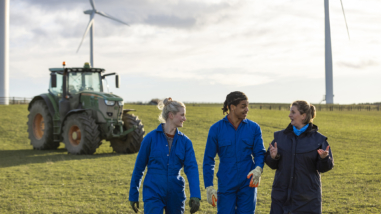This is the second in a five-part series by Hewlett Environment Program Officer Erin Rogers about what charitable philanthropists and nonprofits are learning about ways to convert widespread public support for clean energy and other climate solutions into policy action that can ensure a safer climate for all. Looking at — and beyond — Hewlett’s own grantmaking, Erin shares bright spots where groups are working together to build what academics call “political will” — the complex ecosystem of social forces that help decision makers prioritize problem-solving.
Read Part one: Building political will for climate action
Read Part three: Connection, cooperation, collaboration
I joined the Hewlett team a few years after the epic 2009 cap and trade fail in Congress, rise of the Tea Party, and asymmetrical polarization of climate change among conservatives. My job was to work with grantees to find a path forward. It was immediately clear that many grantee organizations wanted us to expand our philanthropic support to better nurture a more diverse ecosystem of organizations and tactics. This would allow the profusion of public support that already existed to be more intensely and authentically engaged. Hewlett had previously funded more of a mono-crop of national policy and technical groups — doing incredibly important work, but work that was insufficient on its own.
Broadening the Hewlett funding portfolio and working in partnership with other funders to broaden our collective portfolios has enabled a wider array of groups to come to the table on their own terms, and has helped break down the old “environmentalists vs polluters” dichotomy, a false equivalence that diminished the vast and broad public support for climate solutions. Supporting a range of groups who are independently supporting clean energy for many different reasons is helping to de-polarize solutions across both red and blue states, and broadening pathways to yes for decision-makers.
As I mentioned in Part One of this series, the Hewlett Foundation is a nonpartisan charitable foundation, and that means we don’t get involved in elections nor do we earmark our funds for lobbying. But we can provide organizations with general operating support allowing them to be nimble and make decisions that reflect their needs and memberships, and we can support a diverse array of activities including issue-education, nonpartisan research, and other efforts that help increase the willingness and ability of decision-makers to implement and sustain policies that deliver benefits to the public.
North Carolina offers some good examples of the benefits of a healthy advocacy ecosystem. A few years ago, well-funded opponents attempted to dismantle the state’s clean energy policies. Environmental groups and other clean energy advocates and knew that broader business support for renewable energy existed, but it was hard for many influential businesses to engage in complicated state policy advocacy.
Those clean energy advocates requested philanthropic support to help them connect large corporate employers in North Carolina with state policy campaigns on clean energy and customer choice. National groups like Advanced Energy Economy and Ceres partnered with state groups like North Carolina Sustainable Energy Association to enable Fortune 500 companies to educate policymakers on their own growing demand for renewable energy.
Tech giants Apple, Google, and Facebook reminded state decision-makers that “… a reliable, sustainable electricity supply is critical, and requires sourcing power from renewable energy.” Similarly, North Carolina-based VF Corporation, whose brands include Wrangler Jeans and The North Face, joined other major companies to assert that clean energy standards “have provided us the certainty and predictability we need for our business.” Even agribusiness giant Smithfield Foods, the world’s largest pork producer and a major pursuer of renewable energy options, signaled that opposition to the standards sent “mixed signals to investors and could have a detrimental effect on these and future efforts in our industry.”
The fact that businesses and environmental groups (among many others) were able to bring their respective and authentic demands to the table created more of a surround sound for decision-makers and less of a binary choice. These educational efforts created an environment in which advocates were then able to save the renewable energy standards.
Ryan Hodum, Program Director for Southeast Policy at the Energy Foundation, which provides funding to many groups in North Carolina, reflected that, “And a big part of the story is that large and small businesses decided to speak up from every county across the state about their desire for energy that is cheap, clean, and reliable, which opened up new opportunities for bipartisan agreement on state policy.”
That’s great, you may say, but this is still incremental change and not the rapid transition needed. The grantees in North Carolina agree, but are betting that these kinds of efforts, if sustained and grown over time, can be a vital part of a deeper transformational push that, when aggregated with similar efforts in other states, leads to tipping points. The broad coalition in North Carolina continues to grow, and now includes local chambers of commerce, small businesses, retailers, and many others. They continue to build momentum, including in a slew of utility commission cases that could unlock even more renewable energy all across North Carolina.
Nevada offers another example of how a diverse ecosystem of groups and tactics can make a difference. Three years ago, the Public Utilities Commission of Nevada rolled back its net metering rules, crippling the state’s growing rooftop solar industry. Hundreds of solar company employees were laid off. Philanthropic funding in the state was scarce, and few NGOs had the capacity to help channel the vast public support for solar power into policies that would increase public access to solar.
Over the next two years, a wide array of influential constituencies in Nevada sought philanthropic support from an array of foundations. They came from different angles and perspectives but all wanted to support clean energy. Christian Coalition members made a conservative case for clean energy. Ceres coordinated with large corporate clean energy supporters, including Levi Strauss, Unilever, eBay, MGM Resorts, and Tesla. Chispa, the community organizing arm of the League of Conservation Voters, focused engaging its Latino members and supporters, and Faith Organizing Alliance helped other communities of color engage in the process. A diverse coalition began to grow, unified around job creation and other economic benefits that clean energy can deliver.
“We made great progress on climate and energy policy in Nevada in part because we changed the notion of who cares about these issues,” explains Rudy Zamora, Chispa Nevada’s Program Director. “For example, Latino families had never had a robust presence in these policy debates, even though they very strongly support clean energy. We helped them learn the ins and outs of the process and now they are seen as leaders on these issues.” Chispa members advocated for policies that would provide green bank financing for clean energy, creating community solar programs, and electrifying dirty diesel school buses.
“Chispa members would tell decision-makers their personal stories and talk about how dirty energy was making their kids sick. Sometimes, our members testified in Spanish. We helped them get over their fear and their feelings that they couldn’t participate because they spoke Spanish. Their courage and their stories really made an impression on decision-makers.”
In 2016, Nevada’s net metering program was restored with bipartisan support, and new policies for low-income energy efficiency, an electric vehicle incentive program, and other clean energy provisions were enacted. By 2030, this policy suite is expected to decrease Nevada’s global warming pollution by 300,000 tons. The coalition continues to work on implementation and building on their success to push for even more progress.
These are just two examples of the kinds of partnerships between grantees and philanthropy that are happening more and more across the country — building on successes to ratchet up momentum, find new champions, and deepen political will in a virtuous cycle. Hewlett’s U.S. funding portfolio now includes a more diverse ecosystem of grantees including health, consumer, labor, business, faith, conservative, civil rights, and community-based groups. We also provide funding for efforts that support public-private partnerships—bringing together an even wider array of resources and perspectives. These efforts to build a healthy ecosystem approach to climate solutions is essential to building political will toward the rates of change we need to avoid the worst consequences of global warming. But in and of themselves, they are still not sufficient. Much more is needed.
The next installment will focus on the importance of philanthropic funding to support collaboration — ensuring that these diverse grantees’ efforts add up to more than the sum of their component parts.




